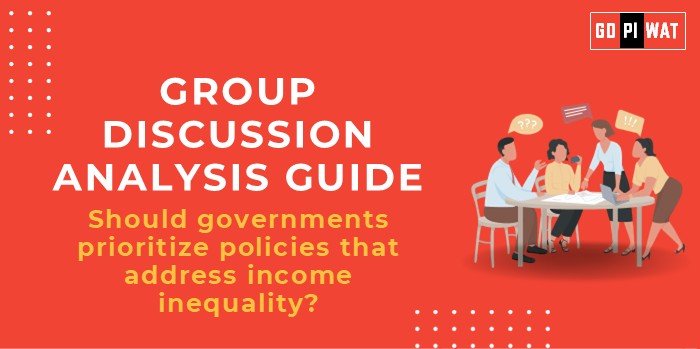📋 Group Discussion Analysis Guide: Should Governments Prioritize Policies That Address Income Inequality?
🌟 Introduction to the Topic
Income inequality remains one of the most pressing issues worldwide, with the top 10% of earners amassing over 50% of global wealth while billions live in poverty. Addressing income inequality is central to achieving social stability, economic growth, and sustainable development. For governments, this prioritization involves a balance between fostering equitable opportunities and maintaining economic competitiveness.
📊 Quick Facts and Key Statistics
- 💰 Global Wealth Share: The wealthiest 1% own 45.6% of global assets (Credit Suisse, 2023).
- 📈 Gini Index: Many countries, including India (0.48) and the U.S. (0.41), have high-income disparities.
- 🌍 Poverty: Around 700 million people worldwide live on less than $2.15 a day (World Bank, 2023).
- 🇩🇰 Policy Impacts: Countries like Denmark and Sweden, with strong welfare programs, have Gini coefficients below 0.25.
🏛️ Stakeholders and Their Roles
- 🏢 Government: Implement progressive taxation, welfare schemes, and educational reforms.
- 💼 Private Sector: Promote equitable wages, CSR initiatives, and social equity.
- 👥 Non-Governmental Organizations (NGOs): Advocate for marginalized communities and run poverty alleviation programs.
- 🗳️ Citizens: Actively participate in democratic processes and promote awareness about inequality issues.
🏆 Achievements and Challenges
✨ Achievements:
- 🌍 Nordic Models: Nations like Norway and Finland have effectively reduced income inequality through universal healthcare and free education.
- 🇮🇳 India’s DBT Scheme: Direct Benefit Transfer saved over ₹2.7 lakh crore by reducing inefficiencies.
- 🎯 UN SDG Progress: Policies aligned with Sustainable Development Goal 10 have reduced extreme poverty by over 20% globally since 2000.
⚠️ Challenges:
- 💸 Tax Evasion: High-net-worth individuals and corporations exploit tax loopholes, reducing state revenue.
- 🌐 Informal Economies: Over 60% of global workers operate in unregulated sectors, limiting their access to social protection.
- 📊 Global Comparisons: Despite strong economic growth, countries like India and Brazil continue to experience rising income inequality compared to Scandinavian nations.
💬 Structured Arguments for Discussion
- ✅ Supporting Stance: “Addressing income inequality ensures social stability, fosters long-term economic growth, and reduces poverty.”
- ❌ Opposing Stance: “Excessive focus on income redistribution can stifle entrepreneurship and economic competitiveness.”
- ⚖️ Balanced Perspective: “Governments should strike a balance, promoting both economic growth and inclusive policies to reduce disparities.”
📌 Effective Discussion Approaches
- 🎯 Opening Approaches:
- 📊 “The top 1% control nearly half of global wealth, underlining the critical need for policy interventions.”
- ⚖️ “While addressing income inequality is essential, economic growth should not be compromised.”
- 🌍 “Scandinavian countries demonstrate how targeted policies can successfully bridge income gaps.”
- 🛡️ Counter-Argument Handling:
- 📖 Example: “While critics argue redistribution stifles growth, countries like Germany maintain strong economies with progressive taxation.”
📊 Strategic Analysis of Strengths and Weaknesses
- 🌟 Strengths: Builds social harmony, increases opportunities for marginalized groups.
- ⚠️ Weaknesses: Risk of over-taxation driving capital flight.
- 🌟 Opportunities: Technological integration in welfare distribution.
- ⚠️ Threats: Political resistance, economic slowdowns.
📚 Connecting with B-School Applications
- 📖 Real-World Applications: Study of welfare economics or CSR strategies in management projects.
- 🗨️ Sample Interview Questions:
- ⚖️ “How can governments balance equity with growth?”
- 📈 “What role should businesses play in addressing income inequality?”
- 📖 Insights for B-School Students:
- 📚 Understanding economic policy frameworks.
- 📊 Developing strategies for inclusive growth in business models.


